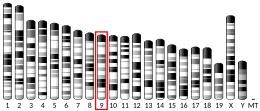호모사피엔스 종의 단백질 코딩 유전자
후각수용체 7D4 는 인간에서 OR7D4 유전자 에 의해 암호화된 단백질 이다.[5] [6] [7] [8] [9] [10] [11]
함수 후각 수용체 는 코의 냄새 분자와 상호작용하여 냄새의 인식을 유발하는 신경 반응을 일으킨다.후각수용체 단백질은 단일 부호화-엑손 유전자에서 발생하는 G단백질결합수용체 (GPCR)의 대가족 구성원이다. 후각수용체는 신경전달물질과 호르몬 수용체가 많은 7-transmembrane 영역 구조를 공유하고 있으며, 냄새제 신호의 인식과 G 단백질 매개 전도를 담당한다. 후각 수용체 유전자 계열은 게놈에서 가장 크다. 이 유기체를 위한 후각 수용체 유전자와 단백질에 할당된 명명법은 다른 유기체와는 독립적이다.[5]
리간즈 OR7D4 R88W/T133M 다형성증을 가진 사람들은 이러한 냄새에 덜 민감하고 그들이 특징적으로 "스위티"[8]
참조 ^ a b c GRCh38: 앙상블 릴리스 89: ENSG00000174667 - 앙상블 , 2017년 5월^ a b c GRCm38: 앙상블 릴리스 89: ENSMUSG000059623 - 앙상블 , 2017년 5월^ "Human PubMed Reference:" . National Center for Biotechnology Information, U.S. National Library of Medicine .^ "Mouse PubMed Reference:" . National Center for Biotechnology Information, U.S. National Library of Medicine .^ a b "Entrez Gene: OR7D4 olfactory receptor, family 7, subfamily D, member 4" . Retrieved 2013-12-17 .^ Fuchs T, Malecova B, Linhart C, Sharan R, Khen M, Herwig R, Shmulevich D, Elkon R, Steinfath M, O'Brien JK, Radelof U, Lehrach H, Lancet D, Shamir R (September 2002). "DEFOG: a practical scheme for deciphering families of genes". Genomics . 80 (3): 295–302. CiteSeerX 10.1.1.135.3652 doi :10.1006/geno.2002.6830 . PMID 12213199 . ^ Malnic B, Godfrey PA, Buck LB (February 2004). "The human olfactory receptor gene family" . Proceedings of the National Academy of Sciences of the United States of America . 101 (8): 2584–9. Bibcode :2004PNAS..101.2584M . doi :10.1073/pnas.0307882100 PMC 356993 PMID 14983052 . ^ a b Keller A, Zhuang H, Chi Q, Vosshall LB, Matsunami H (September 2007). "Genetic variation in a human odorant receptor alters odour perception" . Nature . 449 (7161): 468–72. Bibcode :2007Natur.449..468K . doi :10.1038/nature06162 . PMID 17873857 . S2CID 4417235 . ^ OR7D4+단백질,+인간 (MesH) 미국 국립 의학 도서관 의 의학 과목 제목 (MesH)^ Lunde K, Egelandsdal B, Skuterud E, Mainland JD, Lea T, Hersleth M, Matsunami H (2012). Behrens M (ed.). "Genetic variation of an odorant receptor OR7D4 and sensory perception of cooked meat containing androstenone" . PLOS ONE . 7 (5): e35259. Bibcode :2012PLoSO...735259L . doi :10.1371/journal.pone.0035259 PMC 3342276 PMID 22567099 . ^ Wysocki CJ, Beauchamp GK (August 1984). "Ability to smell androstenone is genetically determined" . Proceedings of the National Academy of Sciences of the United States of America . 81 (15): 4899–902. Bibcode :1984PNAS...81.4899W . doi :10.1073/pnas.81.15.4899 PMC 391599 PMID 6589634 . ^ Hornung J, Noack H, Thomas M, Farger G, Nieratschker V, Freiherr J, Derntl B (February 2018). "Bayesian informed evidence against modulation of androstadienone-effects by genotypic receptor variants and participant sex: A study assessing Stroop interference control, mood and olfaction". Hormones and Behavior . 98 : 45–54. doi :10.1016/j.yhbeh.2017.12.003 . PMID 29246659 . S2CID 3577638 . ^ de March CA, Topin J, Bruguera E, Novikov G, Ikegami K, Matsunami H, Golebiowski J (April 2018). "Odorant Receptor 7D4 Activation Dynamics" . Angewandte Chemie . 57 (17): 4554–4558. doi :10.1002/anie.201713065 . PMC 6268213 PMID 29462498 . 이 기사는 공공영역 에 있는 미국 국립 의학 도서관 의 텍스트를 통합하고 있다.
1급 (어류형 수용체)
클래스 II (각종 특정 수용체)
패밀리 1 패밀리 2 패밀리 3 패밀리 4 패밀리 5 패밀리 6 패밀리 7 패밀리 8 패밀리 9 패밀리 10 가족11 패밀리 12 패밀리 13





